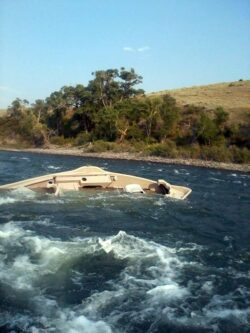 Rowing a Drift Boat takes practice and training. These high-bowed boats can withstand big waves but can also end up in wrecks before the rower knows what happened.
Rowing a Drift Boat takes practice and training. These high-bowed boats can withstand big waves but can also end up in wrecks before the rower knows what happened.
If there is one bit of advice that experienced Drift Boat rowers would share it is “Row away from the danger.” When rowing a Drift Boat, you need to row upstream to have control and steer the boat. Since there is no rudder, you end up out of control if you are going faster than the current or going the same speed.
When you lose control, you hit rocks, go broadside, or wreck. Some inexperienced oarsmen drop the anchor when in trouble. If you are in a run or rapid, the anchor will lock onto the bottom and pull the stern off the boat. This is why you never tie a knot in your anchor rope. Better to lose the anchor than the boat or lives.
If the boat’s stern fails to pull off, the back of the boat will drop down and flood the boat. Once the current flows into the boat, you are swamped.
Recently, a Madison River oarsman must have had a mishap. They lost their boat between Raynolds Pass and $3 bridge. The boat is flooded and broadside against a boulder. The gear is probably spread out downstream. This stretch of river is a “Wade Fishing Only” stretch, but some boaters feel the need to navigate these challenging waters. A better float would be downstream from Lyons Bridge.
Responsible boat sellers should offer a day of rowing instruction. Oarsmen need to understand how to Kant the boat, turn, stop, anchor, and navigate safely. Newbies need to do their homework before launching. There are books, videos, and YouTube shows that supply great information. If the seller offers no training, hire an experienced guide to teach you.
Most bad oarsmen screw up because they do not know how to do anything else. Several years ago, I sold my custom Ro Drift Boat. I took a lot of pride and care to maintain this boat and wanted to pass it along to a responsible new owner. Part of the deal was a day with me in the boat mentoring/ teaching them how to row and handle their new toy. This hands-on lesson is priceless and not only can save lives but also save my special boat.
When you first start learning how to handle a drift boat, go to a pond or lake. Row your brains out. Figure out how to row backwards in a straight line. See how fast you can go forward or backwards. Perform turns, 360-degree spins, beaching, launching, and mooring. Figure out your anchor system.
Wear some gloves, a life vest, polaroid glasses, and shoes with traction. All of these will come in handy. Once you have an idea of how to row, go to a parking lot and figure out how to back your boat trailer up. See if you can go backwards in a straight line for 100 yards and park the boat between 2 lines. This will help you when you go to a launch ramp.
Now you are ready for your first river drift. Pick a BIG river that has safer water. The Yellowstone River has many safe sections that you can practice on reasonably safe. Check with the local fly shops as to what stretches are best. Learn how to set up your shuttle and give the drift a go. You may not want to fish on your first outings. Keep gear to a minimum and focus on how to use your new expensive toy. This time will be a great investment in future floats and fishing.
Invest time, learning, and Row Away safely!
Montana Grant
